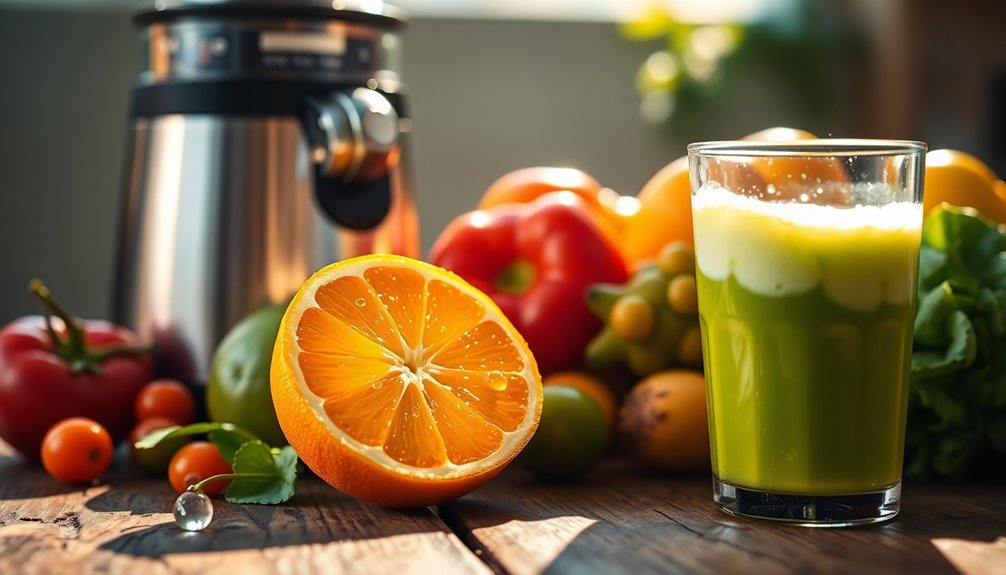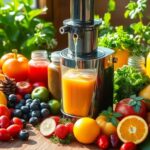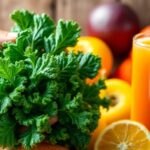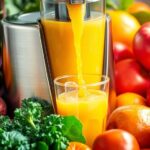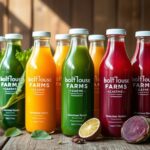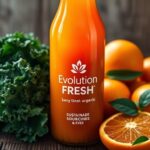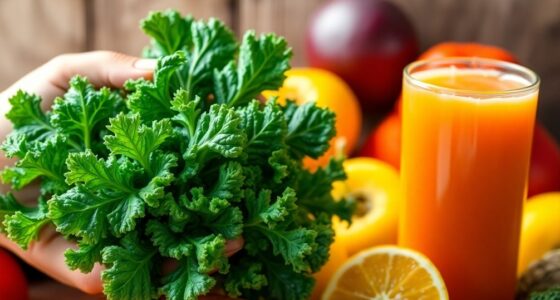In the organic juice manufacturing process, you'll see a careful selection of organic fruits and veggies. They use cold pressing to retain maximum nutrients and flavors. After that, high-pressure processing extends shelf life while keeping most vitamins intact. However, some worry it may strip beneficial bacteria. Local sourcing enhances freshness and supports sustainability. Transparency in labeling is key for trust. Stick around to discover more about innovative trends and community engagement in the organic juice world!
Key Takeaways
- Organic juice begins with selecting pesticide-free and GMO-free fruits and vegetables, ensuring high-quality ingredients for optimal health benefits.
- Cold pressing is employed to extract juice without heat, preserving vitamins, enzymes, and natural flavors while maximizing nutritional value.
- High pressure processing (HPP) extends shelf life to 30-60 days but may compromise beneficial probiotics and some nutrients.
- Transparency in labeling is essential for consumers to verify ingredient quality and avoid misleading health claims.
- Future trends in organic juice manufacturing focus on local sourcing, innovative ingredients, and sustainable packaging to enhance nutritional integrity and sustainability.
Understanding Organic Juice Processing

When you plunge into organic juice processing, you'll discover that it starts with the meticulous selection of organic fruits and vegetables, ensuring they're free from pesticides and GMOs. This careful curation preserves the health benefits you seek.
The juice is typically produced using a two-step method. First, cold pressing extracts juice without heat, maintaining its natural flavors and nutrients. Next, high pressure processing (HPP) comes into play, eliminating pathogens while further preserving those nutrients.
This innovative technique can extend the shelf life of your organic juice to 30-60 days, a remarkable improvement over the usual three days of fresh cold-pressed juices. Transparency in labeling is essential, so always check for ingredient disclosure to avoid misleading claims about your favorite organic drinks.
The Role of Cold Pressing in Nutrient Retention
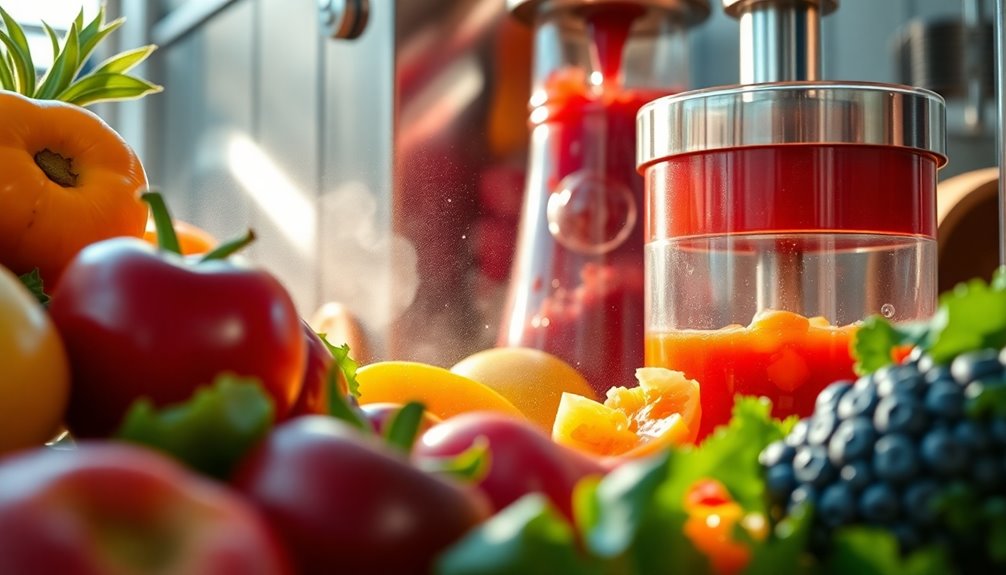
When you think about juice, you mightn't realize how the method of extraction affects its nutritional value.
Cold pressing stands out because it preserves vitamins and enzymes by avoiding heat, unlike other processing methods that can strip away essential nutrients. Understanding how this technique works will help you appreciate the benefits of choosing cold-pressed juices for your health. Additionally, cold-pressed juices often contain fresh ingredients that enhance flavor and nutrition, making them a superior choice for your diet.
Nutrient Preservation Techniques
Cold pressing stands out as a revolutionary technique in organic juice manufacturing, as it preserves the essential nutrients found in fruits and vegetables.
By crushing produce without heat, you can retain up to 100% of the nutritional value, unlike heat pasteurization, which often results in a 40-60% loss. This method minimizes oxidation, keeping your juice vibrant, fresh, and packed with crucial enzymes.
Additionally, high-pressure processing (HPP) may follow cold pressing, extending freshness to 30-60 days without additives.
Using organic produce further enhances the nutrient profile while eliminating harmful pesticides and GMOs.
With cold pressing, you're not just enjoying delicious juice; you're also ensuring it's brimming with the nutrients your body craves.
Cold Pressing Benefits
The benefits of cold pressing extend beyond just retaining nutrients; they greatly enhance the overall quality of the juice.
By crushing and pressing fruits and vegetables without heat, cold pressing preserves 100% of the nutrition, ensuring you get the maximum vitamins and enzymes in every sip. Unlike heat pasteurization, which can lead to a 40-60% loss of nutritional value, cold pressing keeps sensitive vitamins like vitamin C and antioxidants intact.
This method also minimizes oxidation, allowing your juice to maintain its vibrant color and fresh flavor longer. While fresh cold-pressed juices typically last about three days, high-pressure processing can extend shelf life without sacrificing nutrient integrity.
Embracing cold pressing benefits means choosing a healthier, more nutrient-rich juice experience.
Comparing Processing Methods
While traditional juice processing methods often sacrifice valuable nutrients, cold pressing stands out by effectively preserving the integrity of fruits and vegetables. This method crushes fruits and vegetables without applying heat, keeping essential nutrients and enzymes intact.
In contrast, heat pasteurization can lead to a staggering 40-60% loss of nutritional value. After cold pressing, high pressure processing (HPP) is often employed to extend shelf life, allowing juices to last 30-60 days while maintaining 100% of their nutrition.
You'll also enjoy vibrant flavors and natural colors, enhancing your overall experience. Plus, cold pressed juices are usually free from additives, relying solely on the natural taste and health benefits of organic ingredients. It's a win-win for your health and taste buds!
High-Pressure Processing: An Overview

High-pressure processing (HPP) offers an innovative approach to juice pasteurization by using extreme pressure instead of heat, which helps extend shelf life considerably.
With HPP, you can enjoy juices that last up to 30 days or more, unlike the typical 3 days for fresh cold-pressed options.
Here's what you should know about high-pressure processing:
- It effectively reduces pathogens while preserving most nutrients.
- Beneficial probiotic bacteria and essential enzymes may be destroyed.
- Juice recipes often require reformulation to increase acidity.
- Consumers might be misled about the freshness of HPP juices.
While HPP enhances safety for wholesale distribution, it raises questions about the overall health benefits and the perception of freshness in your favorite juices. Additionally, advanced technology in juice manufacturing can complement HPP by increasing production efficiency.
Benefits of High-Pressure Processing for Juice
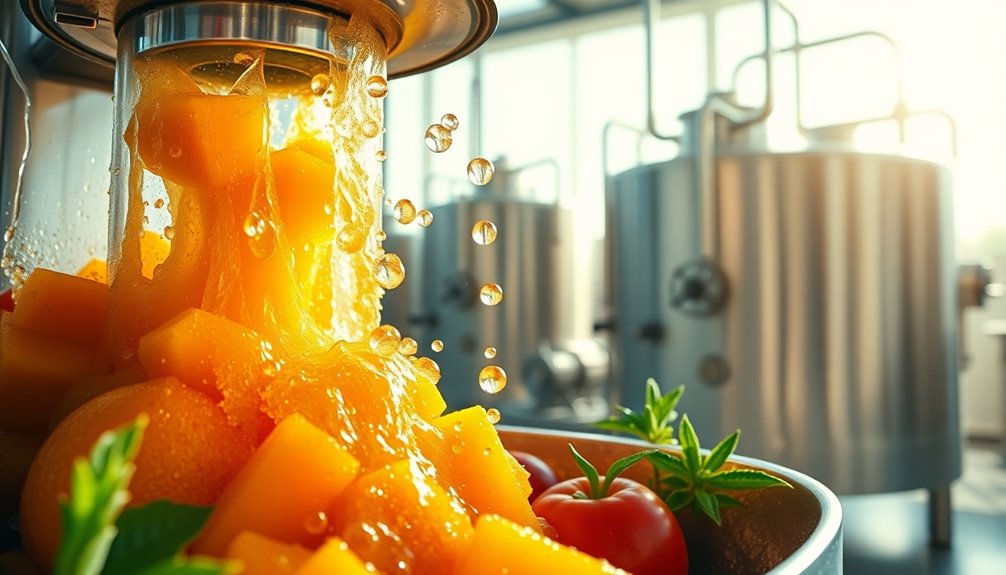
High-pressure processing (HPP) offers you a way to enjoy juice that's both safe and flavorful.
By using extreme pressure instead of heat, it preserves essential nutrients and extends the shelf life to 30 days or more.
This means you get fresh-tasting juice without sacrificing health benefits or quality.
Nutrient Preservation Techniques
When it comes to preserving the essential nutrients in organic juices, High-Pressure Processing (HPP) stands out as a revolutionary technique. By using extreme pressure instead of heat, HPP effectively kills pathogens while maintaining nearly 100% of the juice's nutrients. This means you can enjoy your organic juice without worrying about losing its health benefits.
Here are some key advantages of HPP:
- Preserves flavor and nutritional value
- Extends shelf life to 30-60 days without additives
- Reduces harmful microorganisms
- Provides a safe product for vulnerable populations
While it does kill some good probiotic bacteria, HPP remains one of the best nutrient preservation techniques, ensuring your organic juice stays fresh and nutrient-rich. Additionally, maintaining high vibrational energy during the consumption of healthy juices can enhance your overall wellness experience.
Extended Shelf Life
Using High-Pressure Processing (HPP) can considerably extend the shelf life of organic juices, allowing you to enjoy them for 30 days or more.
Unlike traditional fresh cold-pressed juices, which only last about three days, HPP uses extreme pressure to eliminate pathogens and microorganisms without heat.
This method preserves nutrients while maintaining the juice's flavor and quality, letting you find it in grocery stores without preservatives or additives.
HPP not only makes juices safer, especially for vulnerable populations, but also guarantees you get a delicious product.
However, keep in mind that this process may kill beneficial probiotic bacteria and enzymes, which could limit some health benefits associated with fresh, raw juices.
Why Some Choose to Avoid High-Pressure Processing
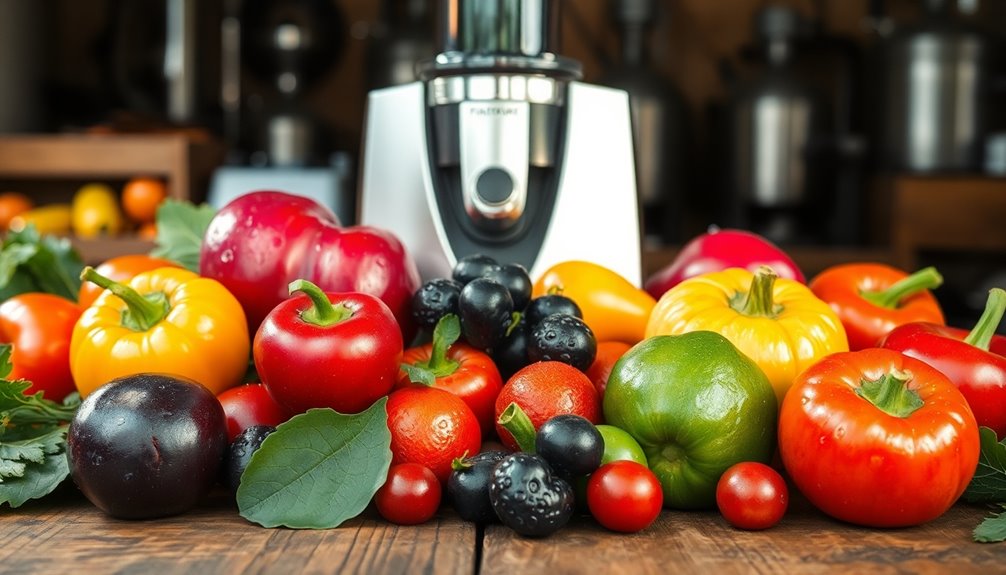
Many consumers are increasingly wary of high-pressure processing (HPP) due to its potential downsides.
While HPP can extend shelf life, it often compromises the health benefits of juices.
Here are some reasons why you might choose to avoid HPP:
- It can destroy beneficial probiotic bacteria essential for nutrition.
- Juices may need to be reformulated for acidity, altering taste and quality.
- HPP juices aren't considered genuinely fresh or raw, misleading consumers.
- Nutritional integrity may suffer as crucial enzymes are diminished.
The Importance of Transparency in Ingredient Sourcing
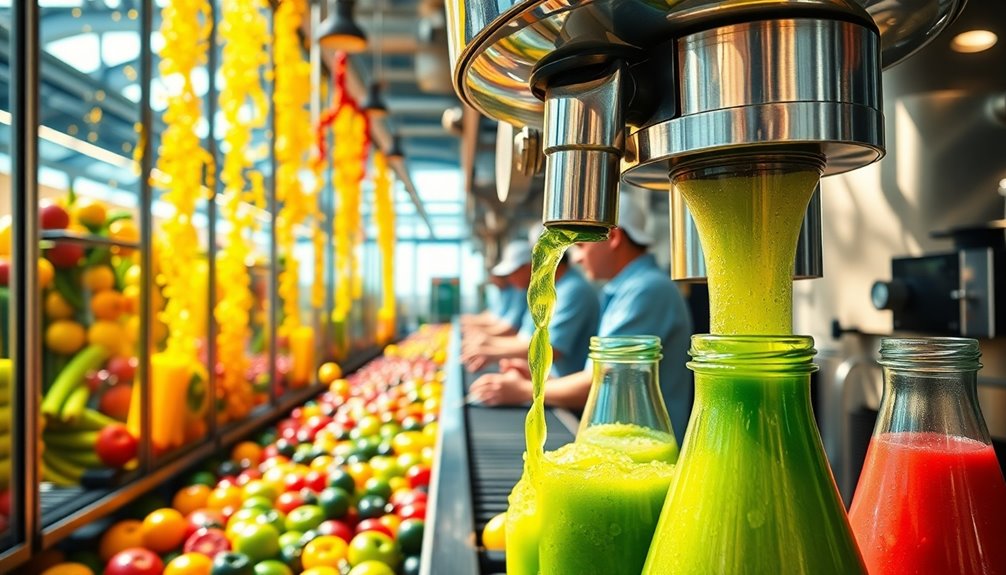
When you choose an organic juice, you want to know where the ingredients come from and what's in your drink. Transparency in ingredient sourcing not only guarantees quality and safety but also builds your trust in the brand. As consumers like you become more aware of what's in their juice, clear labeling and honest ingredient disclosure are essential for manufacturers to maintain loyalty. Additionally, juices rich in vitamins A, C, and E can significantly enhance your overall health and well-being.
Sourcing Organic Ingredients Wisely
Sourcing organic ingredients wisely is essential not just for your health, but also for fostering a sustainable food system. By choosing organic, you're avoiding harmful pesticides and GMOs while supporting local farmers.
In Virginia, where only 2% of agriculture is organic, partnerships with local farms become crucial for accessing seasonal produce.
Here's why transparency in sourcing matters:
- It builds consumer trust in your juice brand.
- You support regional agriculture and community connections.
- You contribute to environmental sustainability.
- You help reduce chronic disease risks.
- Additionally, using natural sweetening alternatives can enhance the flavor profiles of your juices while promoting health.
When you prioritize sourcing organic ingredients, you're not only enhancing your well-being but also promoting a healthier planet for everyone.
Labeling and Ingredient Disclosure
How can you trust the juice you're drinking if the labeling isn't clear? Transparency in labeling and ingredient disclosure is essential for making informed choices.
Many juice products may claim to be "natural" or "organic," but they can still contain non-natural components hiding behind vague labels. You should be aware that high pressure processing (HPP) can strip away beneficial nutrients, leaving you in the dark about what you're consuming.
When companies prioritize clear labeling, it enhances your understanding of ingredient sourcing and quality. Local sourcing, like that of Lumi, not only supports community agriculture but also provides clarity on the origins of the produce. Additionally, understanding the nutritional value of the ingredients can help you choose juices that align with your health goals.
Ultimately, knowing what's in your juice empowers you to make healthier decisions for yourself.
Building Consumer Trust
Transparency in ingredient sourcing not only builds consumer trust but also empowers you to make informed choices about what you consume.
In the juice industry, where labeling can be misleading, knowing where your organic ingredients come from is essential. Companies like Lumi exemplify this commitment by:
- Sourcing local produce, ensuring freshness and quality
- Using only organic ingredients, free from additives and chemicals
- Implementing high-pressure processing (HPP) to preserve nutrients
- Communicating openly about sourcing and production practices
This approach nurtures a stronger bond with health-conscious consumers, reinforcing your confidence in the products you choose. Additionally, understanding the nutritional advantages of organic juice can further enhance your decision-making process regarding health benefits.
Local Sourcing and Its Impact on Juice Quality
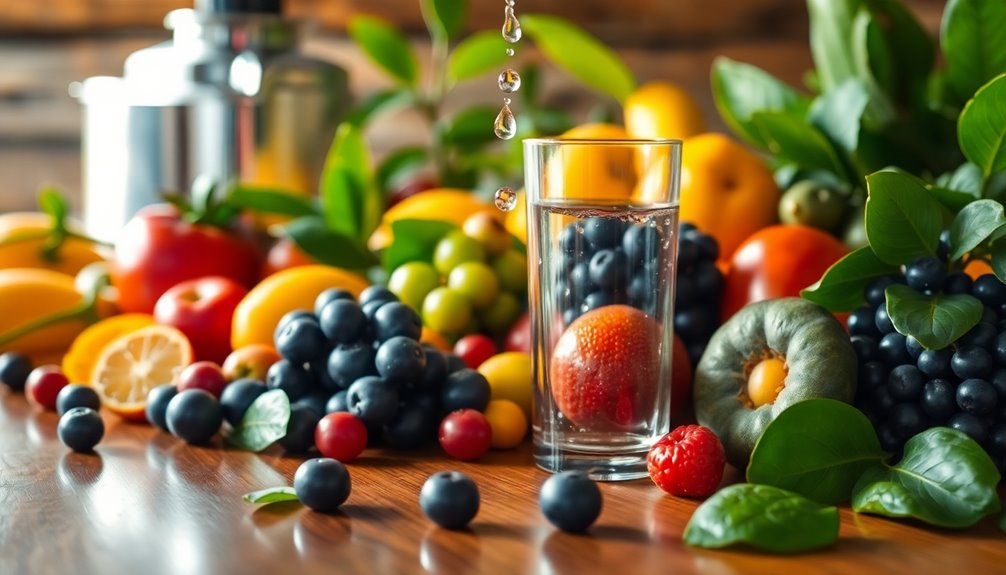
When you prioritize local sourcing for juice production, you not only enhance the flavor and nutritional value of your beverages but also support the local economy.
By using seasonal produce from nearby farms, you guarantee your juices are made from the freshest ingredients, which leads to richer flavors.
In Virginia, where only 2% of agricultural production is organic, partnering with local farms like Sweet Rose Farm is vital for increasing the availability of organic apples.
Local sourcing also reduces transportation emissions, promoting sustainability. Additionally, incorporating folate-rich ingredients into your juices can further support health and wellness initiatives among consumers.
Maintaining Product Integrity Through Innovative Methods
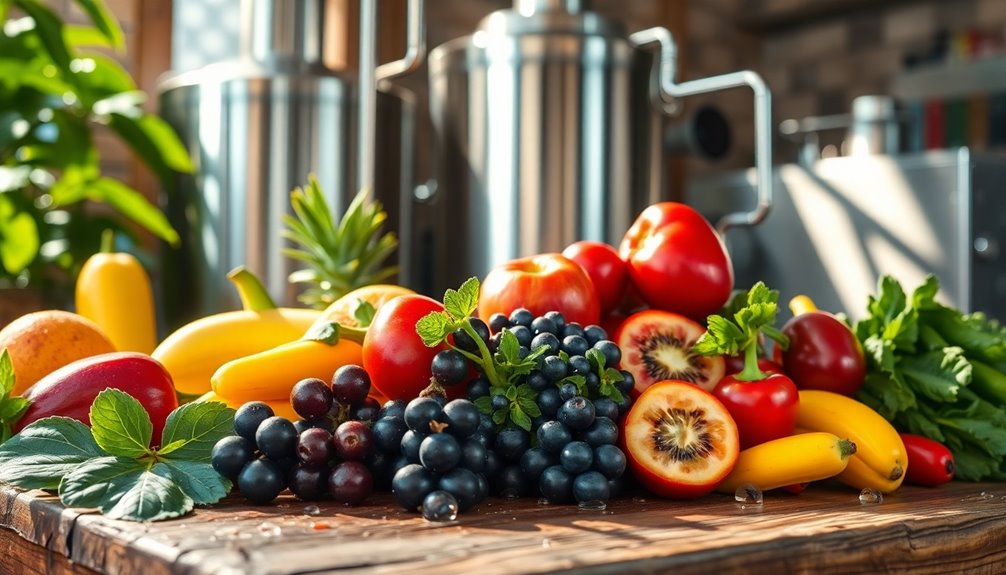
By focusing on local sourcing, you set the stage for maintaining product integrity through innovative methods in juice manufacturing.
Lumi employs a two-step juice processing method that includes cold pressing and high pressure processing (HPP). This technique guarantees you receive 100% of the nutrients and eliminates pathogens without additives.
To enhance product integrity, consider these strategies:
- Use local, organic produce for freshness.
- Emphasize transparency in labeling to build trust.
- Maintain efficient production shifts to guarantee quality.
- Deliver over 2 pounds of organic produce in every bottle for nutritional value.
Incorporating ingredients like chia seeds, which are a rich source of dietary fiber, can further boost the health benefits of your juices.
With these innovative methods, you can confidently enjoy a juice that not only tastes great but also supports your health and well-being.
Community Engagement and Support in Juice Production
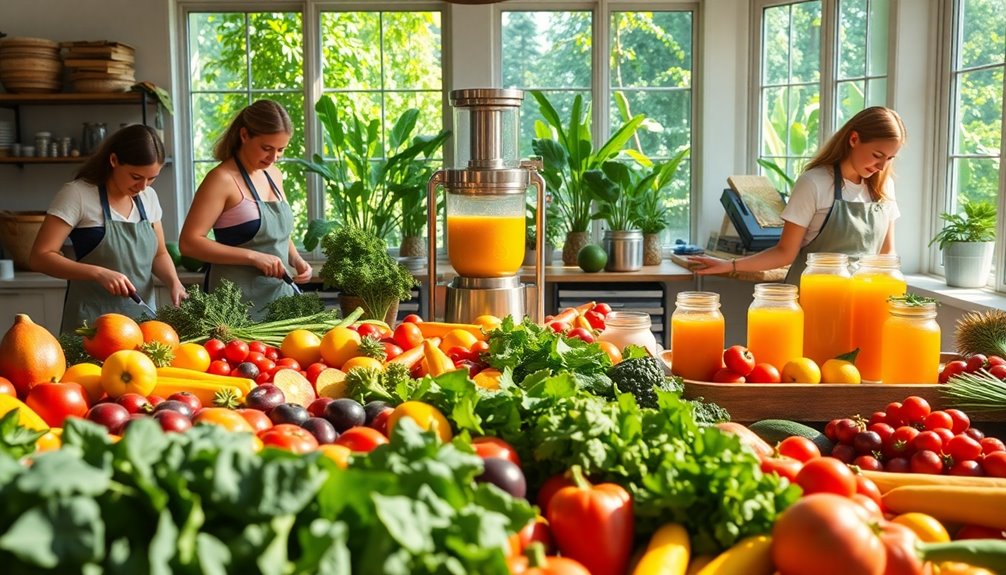
Engaging with the community is essential for fostering a sense of support and shared purpose in juice production.
The GEM plays a pivotal role by creating a network of health-conscious individuals who rally around those fighting cancer. Through initiatives that emphasize the importance of clean, organic whole foods, you can help combat diseases and promote healthy living.
Celebrating milestones, like being cancer-free for ten years, reinforces the GEM's commitment to gratitude and support. This environment allows you to share your health journey and connect with fellow cancer warriors.
As the GEM plans to expand outreach and health education, your involvement will further strengthen the community, making it a vibrant hub for promoting healthy lifestyle practices. Additionally, engaging with local farms helps ensure the use of clean, organic whole foods, which are vital in supporting health initiatives.
Future Trends in Organic Juice Manufacturing
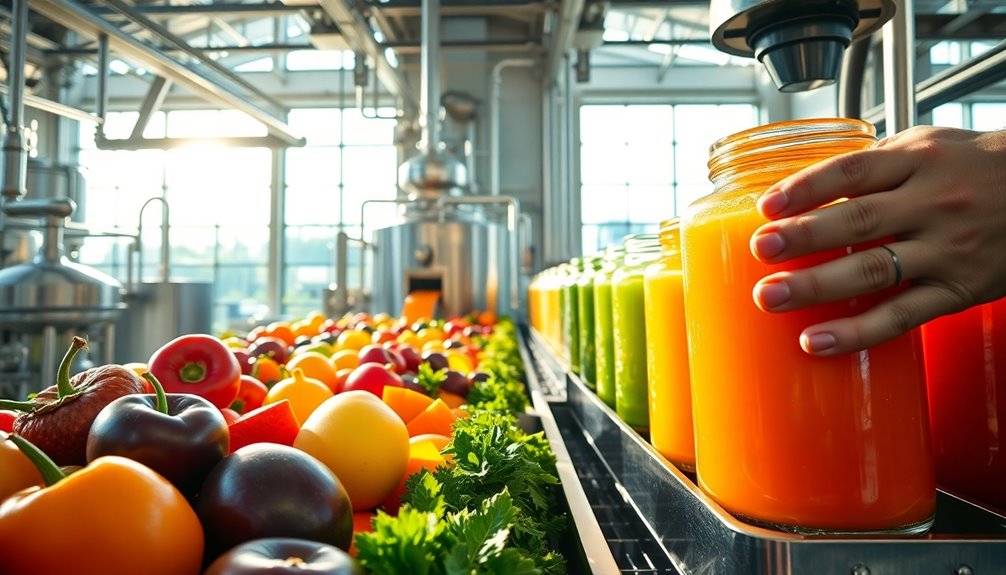
As consumer preferences evolve, organic juice manufacturing is poised to embrace several key trends that will shape its future. You can expect a shift towards high-pressure processing (HPP), which helps maintain nutritional integrity while extending shelf life to 30 days or more.
Additionally, transparency will take center stage with clearer labeling practices, fostering trust between brands and consumers.
Here are some trends to watch for:
- Increased partnerships with local organic farms for seasonal produce
- Incorporation of superfoods and functional ingredients like adaptogens and probiotics
- Sustainable packaging solutions to minimize environmental impact
- Enhanced focus on health benefits to cater to wellness-oriented consumers
These trends not only enhance the product but also align with your values as a health-conscious consumer.
Frequently Asked Questions
What Is the Manufacturing Process of Juices?
When you're looking at the juice manufacturing process, it starts with sourcing high-quality ingredients, often from local farms.
After gathering the fruits and veggies, they go through cold-press extraction, which preserves their nutrients and flavor.
Next, the juice undergoes high-pressure processing (HPP) to eliminate pathogens while retaining its nutritional value.
This method extends the shelf life without any additives, ensuring you get safe, delicious juice with full transparency in labeling.
Where Is Uncle Matt's Orange Juice Made?
You might wonder if all orange juices are created equal, but Uncle Matt's stands out.
Their orange juice is made in Central Florida, where they source 100% organic oranges from local farms. These oranges are harvested at peak ripeness and immediately processed using a cold-press method, which helps maintain their fresh taste and nutrients.
How Is Organic Juice Made?
To make organic juice, you start by selecting fresh fruits and vegetables, ideally sourced from local farms.
Next, you use a cold-press method to extract the juice without applying heat, preserving the flavors and nutrients.
After that, you might apply high pressure processing (HPP) to eliminate pathogens while keeping the juice nutritious.
The result? A delicious, additive-free juice with a shelf life of 40-60 days, packed with the goodness of over 2 pounds of produce!
Is Cold-Pressed Juice Better Than Fresh Juice?
When deciding if cold-pressed juice is better than fresh juice, consider your priorities.
Cold-pressed juice offers a longer shelf life and retains more nutrients, thanks to the hydraulic press method.
However, fresh juice delivers vibrant taste and immediate health benefits but lasts only a few days.
If you're after freshness and flavor, go for fresh juice.
If convenience and nutrient retention matter more, cold-pressed juice might be your best bet.
Conclusion
In the invigorating world of organic juice, you’ve discovered how passion meets innovation. From cold pressing to high-pressure processing, each step plays an essential role in preserving the vibrant nutrients that nature intended. As you sip on that delicious blend, remember that local sourcing and community support elevate your experience. With trends continually evolving, the future of organic juice is as bright as the sun shining through your glass—full of flavor, health, and sustainability. Cheers to that! As you explore the diverse flavors on offer, it’s fascinating to consider the various organic juice production methods that contribute to this rich tapestry of taste. These methods not only enhance the quality of the juice but also reflect a commitment to environmentally friendly practices. By choosing brands that prioritize sustainable sourcing and ethical farming, you not only nourish your body but also support the health of our planet. Every sip is a step towards a greener future!
Cindy thoroughly researches juicing trends, techniques, and recipes to provide readers with practical advice and inspiration. Her writing style is accessible, engaging, and designed to make complex concepts easy to understand. Cindy’s dedication to promoting the advantages of juicing shines through her work, empowering readers to make positive changes in their lives through the simple act of juicing.

